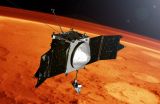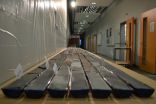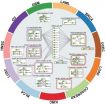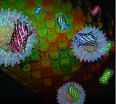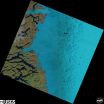(Press-News.org) Early discoveries by NASA's newest Mars orbiter are starting to reveal key features about the loss of the planet's atmosphere to space over time.
The findings are among the first returns from NASA's Mars Atmosphere and Volatile Evolution (MAVEN) mission, which entered its science phase on Nov. 16. The observations reveal a new process by which the solar wind can penetrate deep into a planetary atmosphere. They include the first comprehensive measurements of the composition of Mars' upper atmosphere and electrically charged ionosphere. The results also offer an unprecedented view of ions as they gain the energy that will lead to their to escape from the atmosphere.
"We are beginning to see the links in a chain that begins with solar-driven processes acting on gas in the upper atmosphere and leads to atmospheric loss," said Bruce Jakosky, MAVEN principal investigator with the Laboratory for Atmospheric and Space Physics at the University of Colorado, Boulder. "Over the course of the full mission, we'll be able to fill in this picture and really understand the processes by which the atmosphere changed over time."
On each orbit around Mars, MAVEN dips into the ionosphere - the layer of ions and electrons extending from about 75 to 300 miles above the surface. This layer serves as a kind of shield around the planet, deflecting the solar wind, an intense stream of hot, high-energy particles from the sun.
Scientists have long thought that measurements of the solar wind could be made only before these particles hit the invisible boundary of the ionosphere. MAVEN's Solar Wind Ion Analyzer, however, has discovered a stream of solar-wind particles that are not deflected but penetrate deep into Mars' upper atmosphere and ionosphere.
Interactions in the upper atmosphere appear to transform this stream of ions into a neutral form that can penetrate to surprisingly low altitudes. Deep in the ionosphere, the stream emerges, almost Houdini-like, in ion form again. The reappearance of these ions, which retain characteristics of the pristine solar wind, provides a new way to track the properties of the solar wind and may make it easier to link drivers of atmospheric loss directly to activity in the upper atmosphere and ionosphere.
MAVEN's Neutral Gas and Ion Mass Spectrometer is exploring the nature of the reservoir from which gases are escaping by conducting the first comprehensive analysis of the composition of the upper atmosphere and ionosphere. These studies will help researchers make connections between the lower atmosphere, which controls climate, and the upper atmosphere, where the loss is occurring.
The instrument has measured the abundances of many gases in ion and neutral forms, revealing well-defined structure in the upper atmosphere and ionosphere, in contrast to the lower atmosphere, where gases are well-mixed. The variations in these abundances over time will provide new insights into the physics and chemistry of this region and have already provided evidence of significant upper-atmospheric "weather" that has not been measured in detail before.
New insight into how gases leave the atmosphere is being provided by the spacecraft's Suprathermal and Thermal Ion Composition (STATIC) instrument. Within hours after being turned on at Mars, STATIC detected the "polar plume" of ions escaping from Mars. This measurement is important in determining the rate of atmospheric loss.
As the satellite dips down into the atmosphere, STATIC identifies the cold ionosphere at closest approach and subsequently measures the heating of this charged gas to escape velocities as MAVEN rises in altitude. The energized ions ultimately break free of the planet's gravity as they move along a plume that extends behind Mars.
The MAVEN spacecraft and its instruments have the full technical capability proposed in 2007 and are on track to carry out the primary science mission. The MAVEN team delivered the spacecraft to Mars on schedule, launching on the very day in 2013 projected by the team 5 years earlier. MAVEN was also delivered well under the confirmed budget established by NASA in 2010.
The team's success can be attributed to a focused science mission that matched the available funding and diligent management of resources. There were also minimal changes in requirements on the hardware or science capabilities that could have driven costs. It also reflects good coordination between the principal investigator; the project management at NASA's Goddard Space Flight Center; the Mars Program Office at NASA's Jet Propulsion Laboratory in Pasadena, California; and the Mars Exploration Program at NASA Headquarters.
The entire project team contributed to MAVEN's success to date, including the management team, the spacecraft and science-instrument institutions, and the launch-services provider.
"The MAVEN spacecraft and its instruments are fully operational and well on their way to carrying out the primary science mission," said Jim Green, director of NASA's Planetary Science Division at NASA Headquarters in Washington. "The management team's outstanding work enabled the project to be delivered on schedule and under budget."
INFORMATION:
MAVEN's principal investigator is based at the University of Colorado's Laboratory for Atmospheric and Space Physics in Boulder, and NASA's Goddard Space Flight Center in Greenbelt, Maryland, manages the mission.
For more information about NASA's MAVEN mission, visit: http://www.nasa.gov/maven
A breast cancer specialist and clinical researcher at Women & Infants Hospital of Rhode Island presented research yesterday at the 2014 San Antonio Breast Cancer Symposium showing that adding either the chemotherapy drug carboplatin or the blood vessel-targeting drug bevacizumab to the standard treatment of chemotherapy before surgery helped women who have the basal-like subtype of triple-negative breast cancer.
"We found that adding either carboplatin or bevacizumab to standard preoperative chemotherapy increased pathologic complete response rates for women with basal-like ...
Scientists from the Department of Energy's Pacific Northwest National Laboratory will present a variety of research at the 2014 American Geophysical Union Fall Meeting, which runs Monday, Dec. 15 through Friday, Dec. 19 at the Moscone Convention Center in San Francisco. Noteworthy PNNL research presentations include the following topics:
Even with global warming cold air outbreaks will remain
Just because the climate is warming doesn't mean Cold Air Outbreaks are going away, especially in Southwestern Canada and Northwestern United States. Overall, global climate models ...
Leading conservation scientists from around the world have called for a substantial role for nuclear power in future energy-generating scenarios in order to mitigate climate change and protect biodiversity.
In an open letter to environmentalists with more than 60 signatories, the scientists ask the environmental community to "weigh up the pros and cons of different energy sources using objective evidence and pragmatic trade-offs, rather than simply relying on idealistic perceptions of what is 'green' ".
Organized by ecologists Professor Barry Brook and Professor Corey ...
SALT LAKE CITY, Dec. 15, 2014 - The rate at which carbon emissions warmed Earth's climate almost 56 million years ago resembles modern, human-caused global warming much more than previously believed, but involved two pulses of carbon to the atmosphere, University of Utah researchers and their colleagues found.
The findings mean the so-called Paleocene-Eocene thermal maximum, or PETM, can provide clues to the future of modern climate change. The good news: Earth and most species survived. The bad news: It took millennia to recover from the episode, when temperatures rose ...
PROVIDENCE, R.I. [Brown University] -- Using a computer algorithm that can sift through mounds of genetic data, researchers from Brown University have identified several networks of genes that, when hit by a mutation, could play a role in the development of multiple types of cancer.
The algorithm, called Hotnet2, was used to analyze genetic data from 12 different types of cancer assembled as part of the pan-cancer project of The Cancer Genome Atlas (TCGA). The research looked at somatic mutations -- those that occur in cells during one's lifetime -- and not genetic variants ...
Cold Spring Harbor, NY - The next time you are in a crowded room, or a meeting, or even at the park with your kids, take a look around. How many people are on their phone? Distractions invade every aspect of our lives. Status updates, text messages, email notifications all threaten to steal our attention away from the moment. While we fight the urge to check the phone, our brains are making constant judgment calls about where to focus attention. The brain must continually filter important information from irrelevant interference.
Scientists have hypothesized for decades ...
AMHERST, Mass. - Traditional genomic, proteomic and other screening methods currently used to characterize drug mechanisms are time-consuming and require special equipment, but now researchers led by chemist Vincent Rotello at the University of Massachusetts Amherst offer a multi-channel sensor method using gold nanoparticles that can accurately profile various anti-cancer drugs and their mechanisms in minutes.
As Rotello and his doctoral graduate student Le Ngoc, one of the lead authors, explain, to discover a new drug for any disease, researchers must screen billions ...
Researchers have released one of the most comprehensive assessments of the timing and amount of greenhouse gas emissions that each of the world's major economies could produce under different scenarios, i.e. without new climate policies, for the currently discussed pledges, and under a scenario that limits future temperature rise to 2°C. "The pledges made so far lead to earlier emission peaking in many countries, with 1-1.5 °C less total warming than without these policies, but not sufficient to meet the 2oC target. Under the proposed commitments, cumulative CO2 ...
Advocates of biotech crops and those who favor traditional farming practices such as crop diversity often seem worlds apart, but a new study shows that these two approaches can be compatible. An international team led by Chinese scientists and Bruce Tabashnik at the University of Arizona's College of Agriculture and Life Sciences discovered that the diverse patchwork of crops in northern China slowed adaptation to genetically engineered cotton by a wide-ranging insect pest. The results are published in the advance online edition of Nature Biotechnology.
Genetically engineered ...
Predictions of Greenland ice loss and its impact on rising sea levels may have been greatly underestimated, according to scientists at the University of Leeds.
The finding follows a new study, which is published today in Nature Climate Change, in which the future distribution of lakes that form on the ice sheet surface from melted snow and ice - called supraglacial lakes - have been simulated for the first time.
Previously, the impact of supraglacial lakes on Greenland ice loss had been assumed to be small, but the new research has shown that they will migrate farther ...
